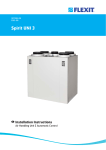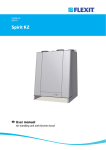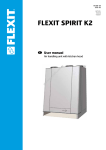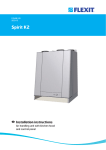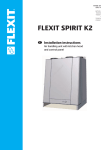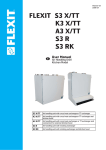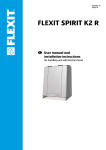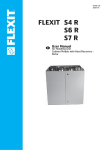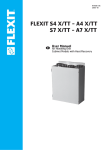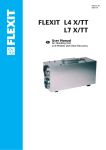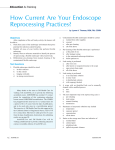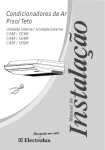Download User Manual
Transcript
110737E-08 2015-09 Spirit UNI 3 User Manual Air Handling Unit & Automatic Control UNI 3 User Manual Contents 1 Functional Description Balanced Ventilation 1.1 Fans (M1, M2) 1.2 Filter (FI1, FI2) 1.3 Heat recovery system (HR-R) 1.4 Heating element (EB1) (for UNI 3 E) 1.5 Temperature sensors (B1, B4) 2 Operation of Handheld Terminal 2.1 Horizontally Wall-Mounted Unit 2.3 Horizontal Unit 2.4 For Necessary Removal of Door 3 Cleaning and Maintenance 3.1 Fans 3.2 Filter 3.3 Replacing the brush strips 3.4 Rotor 3.5 External Cleaning 4 CI60 control unit overview 5 CI60 in use 5.1 General 5.2 Increasing/reducing air supply 5.3 Adjusting the air supply 5.4 Temperature adjustment 5.5 Filter replacement 5.6 Alarm 5.7 Reset 6 CI600 control unit overview 7 CI600 in use 7.1 General 7.2 Idle mode 7.3 Menu navigation 7.4 Start menu 7.5 Operating status 8 CI600 main menu 8.1 Fan speeds 8.2 Max. timer 8.3 Settings 8.4 Temperature 8.5 Timer 8.6 Daily/weekly timer 8.7 Time and date 8.8 Language 8.9 Filter 8.10 Alarm 8.11 Operating information 9 CI600 advanced user menu 9.1 PIN 9.2 Advanced user 9.3 Temperature regulation 9.4 Configuration 9.5 Operating time 9.6 Defrosting 10 Maintenance Table 11 Troubleshooting 12 CE Declaration of Conformity 4 4 4 4 4 4 5 5 6 6 7 7 8 9 9 9 10 11 11 11 11 11 11 11 11 12 13 13 13 13 13 13 14 14 14 14 14 15 15 16 16 16 16 16 17 17 17 17 19 20 21 22 22 23 Our products are subject to continuous development and we therefore reserve the right to make changes. We also disclaim liability for any printing errors that may occur. 2 UNI 3 User Manual ! Important Safety Instructions: It is the installer’s responsibility to carry out a full safety and function assessment of the appliance. To reduce the risk of fire, electric shock or injury, read all the safety instructions and warning texts before using the unit. • • • • • • • • • • This unit is only designed for ventilation air in housings or commercial buildings It must not be used to extract combustible or flammable gases Disconnect the mains plug before commencing any service and maintenance work Before opening the door: switch off the heat, let the fans continue for three minutes to remove hot air, disconnect power from the unit and wait 2 minutes before opening the doors. If the supply cord is damaged, it must be replaced by the manufacturer, its service agent or a similarly qualified person, in order to avoid hazard. The unit contains heating elements that must not be touched when they are hot The unit must not be operated without the filters in place Do not cook any combustible substances under the kitchen hood, if this is installed Do not leave a saucepan or frying pan containing oil or grease unsupervised when using a kitchen hood For the warranty to apply, the user manual instructions must be followed. To maintain a good indoor climate, comply with regulations. To avoid condensation damage, the unit must never be stopped apart from during service/maintenance or in connection with an accident. Symbols Used These products bear a number of symbols used for labelling the actual product and in installation and user documentation. Supply air Extract air Kitchen air DANGER! ELECTRICITY DANGER! DO NOT TOUCH ! Exhaust air CAUTION! When a text bears this symbol, it means that personal injury or serious damage to the equipment may result if the instructions are not followed. Outdoor air NB! When a text bears this symbol, damage to equipment or poor efficiency may be the consequence of not following the instructions. This appliance can be used by children aged from 8 years and above and persons with reduced physical, sensory or mental capabilities or lack of experience and knowledge if they have been given supervision or instruction concerning use of the appliance in a safe way and understand the hazards involved. Note that the product is not intended for use by children. Children shall not play with the appliance. Cleaning and user maintenance shall not be made by children without supervision. EXAMPLE OF NIPPLE LOCATION (shown as a right-hand model) Our products are subject to continuous development and we therefore reserve the right to make changes. We also disclaim liability for any printing errors that may occur. 3 UNI 3 User Manual 1 Functional Description Balanced Ventilation 1.1 Fans (M1, M2) Fig. 1 The fans ensure that air enters and leaves the building. These can be individually adjusted for optimal operation. The unit can be regulated at 3 different speeds using the operating panel; Min, Normal and Max. See section 5.1 for more information. B4 1.2 Filters with a high filter grade (F7) are used as standard both for supply air and extract air, so that the air which enters the building is clean. The filters also ensure that the unit stays clean. 1.3 M2 EB1 FI1 F20 F10 M1 Heat recovery system (HR-R) The air goes through the rotary wheel heat recovery system. The rotor functions as a heat storage. The heat from the extract air heats up one half of the rotor. When the heated part comes over to the supply air side, the heat is transferred to the supply air. HR-R M4 K 1.4 Heating element (EB1) (for UNI 3 E) If the heat recovery system cannot raise the temperature enough, an electrical heating element will raise the temperature to a set level. The heating element is protected against overheating by the thermostat (F20), which switches off at 60°C. As an additional safety measure, the F10 thermostat switches off at 85°C. The F10 thermostat must be reset manually by pressing the reset button (see Fig. 2). 1.5 B1 Filter (FI1, FI2) Fig. 2 Temperature sensors (B1, B4) The unit has two temperature sensors as standard. Supply air sensor B1 registers the temperature of the heating battery. The outdoor air sensor (B4) registers the temperature of the outdoor air. reset button 4 FI2 UNI 3 User Manual 2 Operation of Handheld Terminal 2.1 Horizontally Wall-Mounted Unit 2.2 Sideways Wall-Mounted Unit 1. 1he unit is opened by first unscrewing the screw in the top (see Fig. 3). 2. Pull the handles out, and rotate to the side (see Fig. 4). 3. The door can now be opened to hang open at 180º (see Fig. 5), or be hooked off (see point 2.4). NB! A sideways mounted unit must have a strap and end studs installed, so that the door does not become damaged or fall off when opened. 1. Ensure that the end studs and strap are installed (Fig. 6 and Fig. 7). 2. Unscrew the top screw (see Fig. 3). 3. Pull the handles out, and rotate to the side (see Fig. 4). 4. The door can now be opened, but will have a maximum swing of 105º (se Fig. 7). Fig. 3 Fig. 6 Fig. 4 Fig. 5 Fig. 7 MAX 180° MAX 105° 5 UNI 3 User Manual 2.3 Horizontal Unit 1. Ensure that the end studs and strap are installed (see Fig. 6 and 7). 2. Unscrew the top screw (see Fig. 3). 3. Pull the handles out, and rotate to the side (see Fig. 4). 4. The door can now be opened, but will have a maximum swing of 105º (se Fig. 8). Fig.MAX 8 Fig. 40-105° 9 105° MAX 105° 40-105° 2.4 For Necessary Removal of Door The door can be removed when it is open between 40º and 105º (see Fig. 9). If there is limited space in front of the unit, the lock screw under the door can be temporarily unscrewed (see Fig. 10), as well as the end studs if these are installed (see Fig. 6). Then the door can be pushed out sideways (see Fig. 11). ! CAUTION! The door weighs 10kg, take care when removing it. Fig. 10 Fig. 11 6 UNI 3 User Manual 3 Cleaning and Maintenance CAUTION! Before opening the door: switch off the heat, let the fans continue for three minutes to remove hot air, disconnect power from the unit and wait 2 minutes before opening the doors. ! ! 3.1 CAUTION! For safety reasons, always mount the door screw when you’re finished maintaining the ventilation unit! Fans The fans must be cleaned a minimum of once a year. Clean the fan blades with detergent (for example methylated spirit) on a cloth and compressed air if possible. NB! Do not use water. To take out the fans: 1. Loosen the screw on the fan door (see Fig. 12). 2. Pull out the electric quick-release contact for the motor (see Fig. 13). 3. The fan can then be carefully pulled out of the unit (see Fig. 14). 4. Loosen the screws and remove the fan cover to access the fan blades. Fig. 12 Fig. 13 Fig. 14 1 2 7 UNI 3 User Manual 3.2 Filter Fig. 15 The filters have a limited lifetime, and to preserve a healthy indoor air quality it is important to change them when they are dirty. How often the filters need to be changed depends on the degree of contamination in the air where they are installed. In general, the filters need to be changed a minimum of once a year, preferably in the autumn (after the pollen season). In areas with a lot of dust and contamination, the filters should be changed in the spring and autumn. Dirty filters can, among other things, lead to: • Reduced performance of the unit • The unit becoming dirty • Humidity damage in the bathroom • Reduced indoor air quality A filter subscription is recommended to ensure full benefit from the system. The article number for a replacement filter set is 110716. To take out the filters: 1. Grip the handle and pull the filter cassette out (see Fig.15). 2. Push the filter out of the cassette (see Fig.16). 3. Insert a new filter. NB! Ensure that the filter is not damaged during installation. Use the filter’s outer edge when you push it in. A damaged filter reduces the unit’s effect and the air’s purity. Fig. 16 When changing the filter, check that the whole unit is working normally. Use the following checklist: • Check that the rotor is rotating (see Fig. 17). • The unit has filters both for outdoor air and extract air. • Check that the fans are clean. Fig. 17 NB! When inserting the filter cartridge into its slot, push it properly to prevent air leakage. 8 UNI 3 User Manual Fig. 18 3.3 Replacing the brush strips The brush strips become worn over time. If they do not sit tightly against the rotary wheel-type heat exchanger, it can be necessary to replace them (art.no.110894). Alternatively, they can be moved closer to the rotor, where the aluminium profile they are mounted in has two grooves. Do the following: 1. Pull the rotor a little way out (see Fig. 18). 2. Unplug the quick-release contact fastened to the rotor (see Fig. 19). 3. Pull the rotor out completely. 4. Remove the screw in the centre of the aluminium profile and pull the profile out (see Fig.20). 5. Pull the brush strips out of the groove. Move them up from level 1 to level 2 (see Fig. 21), or replace them with new ones if they are completely worn out. 3.4 Rotor As the unit has high impermeability, filters installed, it is not usually necessary to clean the rotor. If, for various reasons, it should still be necessary, dust can be removed with a soft brush. Further cleaning is possible if you remove the rotor, spray it with fat-soluble detergent and then blow it clean from the opposite side. Distance approximately 60 mm and max. pressure 8 bar. Ensure that the motor is not exposed to water during cleaning. Ensure that all seals around the rotor are intact and tight. Ensure that there is no damage to the rotor belt, and that the rotor rotates freely. 3.5 Fig. 19 External Cleaning Many kitchen surface cleaners contain chemicals that may damage the product’s plastic components. Therefore use a soft cloth moistened with warm water and a neutral detergent to clean the outside of the product. NB! Do not use abrasive cleaners or scouring powder, as such products can damage the surfaces. Do not use cleaners containing citric acids or ammonia. Products that give stainless steel an anti-fingerprint coating must not be used either. Fig. 20 Fig. 21 level 1 level 2 9 CI60 User Manual 4 CI60 control unit overview 8 3 4 9 1 5 10 2 6 11 7 12 No. Description No. Description 1 Switch for increased ventilation 8 2 Switch for decreased ventilation Potentiometer for adjusting extract air at NORMAL speed 3 Indication of MAX speed 9 Potentiometer for adjusting supply air at NORMAL speed 4 Indication of NORMAL speed 10 Switch for additional heating OFF/ON 5 Indication of MIN speed 11 6 Indication of ALARM Potentiometer for adjusting supply air temperature 7 Indication of FILTER REPLACEMENT 12 Switch to reset the alarm *The figures are used as references in subsequent descriptions 10 CI60 User Manual 5 CI60 in use 5.1 General 5.4 Temperature adjustment The control unit consists of a touch panel with pushbuttons, LEDs for indication and adjustment potentiometers and switches for adjusting the ventilation unit. The control unit communicates with the ventilation unit via a low-voltage cable. 5.2 Increasing/reducing air supply Use switches 1 and 2 to increase and reduce the fan speed and thus the air flow. Different speeds depending on the operating situation. MIN Do not use during first year of operation, or when the building is in use. NORMAL Used under normal conditions. In this setting, the air supply must be adjusted according to current regulations. MAX Used if there is a need for increased air supply on account of increased occupancy or a higher humidity level, for example during showering or when clothes are being dried. This setting is usually used for limited periods of time. The temperature required in the supply air can be set with potentiometer 11. The adjustment range is 10 - 30 °C. Using the factory settings is recommended. If necessary, the ventilation unit’s additional heating can also be switched OFF/ON with switch 10. ON ITEM 10 5.5 Filter replacement Every six months, LED 6 lights up to remind you that it is time to replace the air filters in the unit. See section 3 for more information on filter replacement. After the activity has been carried out, the indicator must be reset. See more under the Reset section. 5.6 Alarm The different speeds are indicated with LEDs 3, 4 and 5. 5.3 Adjusting the air supply At NORMAL speed level, the air flow must be adjusted according to project data. Potentiometer 9 is used for the supply air level and potentiometer 8 for the extract air level. The adjustment range is 20-100% of the maximum level according to the scale of the potentiometer. 50% (fixed) NORMAL 75% (variable) MAX 100% (fixed) ! If anything unforeseen occurs with the ventilation unit, indicator 6 lights up. The signal given by the indicator depends on the reason for the indication. A permanent light indicates: • Fault return water detector (B5) • Heat recovery fault (B) A permanent light with indicator 5 (MIN speed) flashing indicates: • Fault supply air detector (B1) • Fault extract air detector (B3) • Fault outdoor air detector (B4) Factory settings: MIN OFF 9 8 10 11 A flashing light indicates: • Overheating thermostat fault (applies only to electric heating) • Fault in external fire/smoke detector (accessory) • Heat recovery fault (A) • Additional heating fault (applies only if the unit has a water battery) 5.7 Reset After the filter has been replaced or the cause of the alarm repaired, the alarm must be reset. This is done by pressing switch 12. If the indicator goes out, the action has been carried out correctly. If the indicator remains on, the fault has not been repaired correctly. 11 CI600 User Manual 6 CI600 control unit overview 6 1 7 2 8 3 9 4 5 No. Description 1 UP/INCREASE switch 2 BACK/CANCEL/NO switch 3 DOWN/DECREASE switch 4 OK/YES switch 5 HELP switch 6 Display 7 Indication of OPERATION/OK - Green light 8 Indication of FILTER REPLACEMENT - Yellow light 9 Indication of ALARM - Red light *The figures are used as references in subsequent descriptions 12 CI600 User Manual 7 CI600 in use 7.1 General The control unit consists of a colour display, a touch panel and indicators (LEDs). The unit communicates with the ventilation unit via a low-voltage cable. 7.2 Idle mode If you select a function that has numerical values, the current value is displayed with a light blue cursor. The value is changed with buttons 1 and 3 and is then confirmed by pressing button 4. If the touch panel is not used, the control unit will, after a certain period of time, enter idle mode, in which operating information will be displayed. B A TIME AND DATE TIME DAY MONTH YEAR C 13 : 45 04.07.09 04 07 09 OK? 13.08.2009 16:43 18°C 22°C If several values can be changed, the cursor jumps to the right when a selection is confirmed with button 4. The procedure is repeated until all values have been changed to the desired values. - NORMAL D A. B. C. D. E. F. E F Time and date Outdoor air temperature Room temperature Current speed Additional heating activated/deactivated Daily/weekly timer active If you want to cancel a function or return to the previous menu screen, use button 2. Button 5 activates a help text that briefly describes the current menu screen. 7.4 Start menu When the system is started, a start menu is opened. START MENU 7.3 Menu navigation LANGUAGE TIME AND DATE MAIN MENU Buttons 1 and 3 are used to navigate through the menu lines. The cursor is illustrated by the line being light blue. If it is possible to make a selection on the current menu line, this is displayed with OK? to the right of the line. A selection is confirmed by pressing button 4. If a menu line contains submenus, this is illustrated with a ‘>’ sign at the end of the line. OK? > > SETTINGS TEMPERATURE TIMER DAY/WEEK SETTINGS TIME AND DATE LANGUAGE FILTER ALARM ADVANCED USER OPERATING INFORMATION > > OK? > > > > > > The basic language and date settings are set in this menu. When this activity has been carried out, you choose to go to the main menu. 7.5 Operating status In normal operation without problems, the green LED 7 lights up to confirm that everything is working normally. How any problems affect the system is described in subsequent sections. 13 CI600 User Manual 8 CI600 main menu 8.1 Fan speeds 8.2 Max. timer The main menu contains various choices. Most concern fan speeds. The speed selected is indicated with large fan symbols and bold font. This menu item activates a function that increases the speed to MAX for a limited period of time before subsequently returning to the speed selected previously. The period of time can be adjusted under the SETTINGS menu item. MAIN MENU MIN NORMAL MAX MAX TIMER SETTINGS MAIN MENU MIN NORMAL MAX MAX TIMER OK? OK? > SETTINGS > To change the speed, move the cursor with buttons 1 and 3. When the function is active, the time is counted down on the display. If you select TIMER OFF, the function will be cancelled and the speed will return to the previous selection. MAIN MENU MIN NORMAL MAX MAX TIMER 8.3 Settings Under the SETTINGS menu item, you can adapt the system as you want. OK? SETTINGS SETTINGS TEMPERATURE TIMER DAY/WEEK SETTINGS TIME AND DATE LANGUAGE FILTER ALARM ADVANCED USER > Then confirm your selection with button 4 and the speed selected is highlighted with large fan symbols and bold font. MAIN MENU MIN N NORMAL MAX M M MAX TIMER > > OK? > > > > > 8.4 Temperature OK? Here you set the temperature for the air that enters the building. TEMPERATURE SETTINGS > 18 °C HEATING ELEMENT ON/OFF 14 OK? > CI600 User Manual We recommend adjusting the temperature to max 18° so that the air is mixed optimally with the air already in the building. 8.6 Daily/weekly timer The programming of the timer begins by selecting the day. DAY / WEEK SETTINGS In the HEATING ELEMENT OFF/ON menu item, the additional heating in the ventilation unit can be switched off. In such case, only the rotating heat exchanger is used as a source of heat. MONDAY TUESDAY WEDNESDAY THURSDAY FRIDAY SATURDAY SUNDAY NB! This is not possible if the unit is installed with a water battery. If the heating element is switched off, this symbol is displayed when the display enters idle mode. OK? A new menu screen appears under each day. HEATING ELEMENT ON/OFF TUESDAY HEATING ELEMENT ON OK? 1 08: 00-16 : 00 MIN 16° 2 16 : 00- 18: 00 NORMAL 18° 3 18 : 00-19 : 00 MAX 16° 4 19 : 00-24 : 00 NORMAL 18° 8.5 Timer Here you set the time you want for the MAX TIMER function. This is used when the function is activated from the main menu. TIMER 60 min OK? Each day can be programmed with four different time intervals. Adjust the start and stop times for each interval and then adjust the desired speed and temperature. To activate the interval, select a green tick. A red cross means that the interval is not activated. If necessary, then select another interval and repeat the procedure. NB! The following rules apply to the programming: • An interval can never commence before a previous one has been finished. • The stop time can never appear before the start time. After you have finished programming a day, repeat the procedure for other days. When the timer is active, this symbol is displayed when the display enters idle mode. If there is no new time interval registered after the finished period, the speed and temperature return to the setting that was previously active. 15 CI600 User Manual 8.7 Time and date INTERVAL CHANGE OF FILTER The time and date can be adjusted in this dialog. TIME AND DATE TIME 6 MND DAY MONTH YEAR 13 : 45 04.07.09 04 07 09 OK? OK? When the filter alarm is triggered, the yellow indicator 8 lights up and an information text appears. Follow the instructions in the text. It is possible to go directly to this dialog from the message or via the menu tree. After the alarm has been reset, the countdown to the next filter replacement begins. 8.8 Language The language selected can be changed in this dialog. 8.10 Alarm LANGUAGE NORSK ENGLISH SVENSKA DEUTCH NEDERLANDS SUOMI DANSK If a problem occurs in the operation of the ventilation unit, an alarm will be triggered. The red indicator 9 lights up and an information text appears in the display. Follow the instructions in the text. It is possible to go directly to this dialog from the message or via the menu tree. OK? ALARM OK? RESET ALARM 8.9 Filter A reminder appears regularly in the display. In this dialog, the time interval can be adjusted and the filter alarm reset. FILTER INTERVAL CHANGE OF FILTER RESET FILTER ALARM 8.11 Operating information > OK? This general screen displays current temperature values, whether the daily/weekly timer is active and activity as 0-100% for cooling, heat exchanger and additional heating. OPERATING INFORMATION SET TEMPERATURE DAY / WEEK SETTINGS SUPPLY AIR EXTRACT AIR OUTDOOR AIR RETURN WATER HEAT RECOVERY SYSTEM COOLING HEATING The normal interval is 6 - 12 months, depending on the environment. 16 22° AKTIV 22° 21° 0° 35° 100% 0% 100% CI600 User Manual 9 CI600 advanced user menu NB! For more information on the ”Advanced User” menu, refer to the ”CI600 Reference Manual” on Flexit’s homepage. 9.3 Temperature regulation In this menu screen, you configure the temperature regulation and cooling functions. 9.1 PIN TEMPERATURE REGULATION To access the menu item, you need to enter the PIN 1 0 0 0. REGULATION TYPE COOLING NEUTRAL ZONE EXT. TEMP. CONTROL PIN CODE 1 0 0 0 > > OK? > OK? Regulation type If supply air regulation is selected, no further settings can be set here. If extract air regulation is selected, the max. and min. supply air temperatures can also be specified. 9.2 Advanced user This menu contains functions for monitoring, configuration and troubleshooting. REGULATION TYPE REGULATION MAX SUPPLY AIR TEMP MIN SUPPLY AIR TEMP ADVANCED USER TEMPERATURE REGULATION FAN REGULATION CONFIGURATION OPERATING TIME FACTORY SETTINGS SERVICE EXTR OK? 35° 15° > OK? > > > > Cooling NB! Flexit does not supply or project cooling machines. In this dialog, the cooling function is activated and the parameters MIN OUTDOOR AIR TEMP for supply of cooling and MIN SPEED for supply of cooling are specified. If a DX cooling machine is used, the supply delay interval can be specified. COOLING COOLING MIN OUTDOOR TEMP MIN SPEED RESTART DELAY COOLNESS RECOVERY 17 AV OK? 18° MIN 180 s > CI600 User Manual It is also possible to activate a function to recover cooling in the building using the rotating heat exchanger. Enter the desired difference between the outdoor and indoor air temperatures for when the function is activated. Fan control The fans are selected and configured in this menu screen. FAN REGULATION COOLNESS RECOVERY COOLNESS RECOVERY DIFF OFF 1° SUPPLY AIR EXTRACT AIR TIMER AIR VOLUME COMP OK? Adjustment (supply air and extract air) This dialog is identical for the supply air and extract air fans. The fans are adjusted individually to the desired capacity for the respective speed. Neutral zones To achieve more even temperature regulation, the neutral zones can be set in this menu. SUPPLY AIR NEUTRAL ZONE COOLNESS RECOVERY HEAT RECOVERY SYSTEM 2° 1° MIN SPEED NORMAL SPEED MAX SPEED OK? Factory settings: External temperature control Control of the temperature settings from an overall system must be entered in this menu. In this case, the temperature settings in the control unit are overridden. EXT. TEMP. CONTROL EXT. TEMP. CONTROL > > OK? > OFF OK? 18 MIN 5V NORMAL 7,5V MAX 10V 50% OK? 75% 100% CI600 User Manual 9.4 Configuration Timer Settings are entered in this menu for the speed and time that are to apply to the ‘MAX TIMER’ function in the main menu. The general configuration is set in this menu screen. CONFIGURATION STANDARD SPEED STANDARD TIME MAX OK? 30 m Air flow rate compensation This function can be activated via an input on the control card. The speeds required for each fan are selected here. The function can be used with a kitchen fan or other device that requires additional supply air. Sensors The temperature sensors can be calibrated in this menu to be better coordinated with the real situation, and a pressure sensor is activated as a pressure guard instead of the integrated time control. SENSORS AIR VOLUME COMPENSATION SUPPLY AIR EXTRACT AIR > > OK? > > SENSORS FIRE/SMOKE COMMUNICATION START/STOP SEQUENCE REST MODE TIMER > > OK? > > SUPPLY AIR EXTRACT AIR OUTDOOR AIR RETURN WATER FILTER GUARD MAX OK? MIN The menu screen is identical for all temperature sensors and they can be adjusted within an interval of 5 °C. SUPPLY AIR CALIBRATION 19 0 OK? CI600 User Manual If the pressure guard is activated, an external sensor must be connected to the control card. The sensor replaces the integrated filter time control. Communication Proceed to the ‘HOME/AWAY’ submenu. COMMUNICATION FILTER GUARD ACTIVATION HOME/AWAY OFF Fire/Smoke This function requires an external sensor to be connected to the control card. The settings are entered for the AWAY selection. Speed and temperature can be selected, plus how long after activation the new setting should take effect. Standby mode In this menu you can adjust the time it takes before the display enters idle mode. FIRE/SMOKE MODE OK? OK? 1 OK? REST MODE TIME DELAY Mode 2 min OK? Supply air fan Extract air fan 1 STOP STOP 2 MAX MAX 3 STOP MAX 9.5 Operating time 4 MAX STOP This menu screen displays the ventilation unit’s total operating time and how much time has passed since the last filter replacement. OPERATING TIME OPERATING TIME FILTER 20 312 tim 125 tim CI600 User Manual 9.6 Defrosting The integrated defrosting function is deactivated on delivery of the ventilation unit. The function can be configured or activated in this menu screen. Password given only in consultation with the Flexit service organisation. Search path to menu screen: MAIN MENU/SETTINGS/ADVANCED USER/SERVICE/ DEFROSTING DE-ICING DE-ICING START TEMPERATURE ROTOR SPEED FAN REDUCTION OFF -15° 25 -25° OK? Defrosting Activates/deactivates the function. Start temperature The start temperature for the defrosting function is set here. The temperature in question is the outdoor temperature. Rotor speed When the start temperature has been reached, the speed of the drive motor of the rotating heat exchanger is reduced to the specified RPM. Fan reduction As an additional safety function, the speed of the supply air fan can be reduced. This takes effect at the set outdoor temperature. Defrosting - Parameters Parameter Default Area Unit Defrosting OFF OFF/ON Start temperature -15 (-5)-(-45) °C Rotor speed 25 15-180 RPM Fan reduction -25 (-5)-(-45) °C 21 UNI 3 User Manual 10 Maintenance Table Component Action Interval Filters Filters must be replaced at least once a year. It is recommended to change them twice a year, 6-12 before and after the pollen season. Check that the filter seal is completely tight. months Fans Fans must be cleaned at least once a year to maintain fan efficiency. 12 months Rotor Check that the surfaces are clean. Check that the sealing strips face in towards the rotary wheel-type heat exchanger. Check that the rotor belt is whole and not too slack. 12 months Kitchen hood* Wash the grease filter. Check that the damper is clean and closes fully. 2 weeks Seals Check that the seals in the unit are intact. 12 months Valves To be cleaned at least once a year. 12 months Air intake Check that no leaves or other items have caught in the grille. In frost mist periods during winter the air intake can freeze up. If necessary it must be scraped clean so that the air can pass through. 12 months Roof cowl If the unit has a roof cowl, this must be checked for leaves and the like. Also check that the drain slots are open. 12 months Ducts Check that the ducts are clean. 10 years Brush strips Check that the brush strips are whole and sit tightly against the rotor. If they are worn they can be moved to the next groove in the profile, so that they are closer to the rotor. 3 years Inside unit A combination of a very low outside temperature and damp extract air can lead to the formation of ice. Normally this will not be a problem - when normal operating conditions return the ice crystals will be converted to damp and be removed from the unit via the exhaust air. In the case of extreme cold over longer periods the unit should be checked for ice. *For units with extract air from the kitchen hood connected to the unit. 11 Troubleshooting Type of fault Remedial action Cold draughts Check which supply temperature has been selected. See operating panel. Check that the rotor is rotating. Check that heating comes on. Needs new extract filter. Fans not working Check that the power to the unit is connected. Check that the thermostat has not cut out. Reset by pressing the button. Must also be reset on the automatic panel. Low air volume Check the speed the unit is set to. Check that the filters are tight. Check the intake grille. 22 UNI 3 User Manual 12 CE Declaration of Conformity This declaration confirms that the products meet the requirements in the following Council Directives and standards: 2004/108/EC Electromagnetic Compatibility (EMC) 2006/95/EC Low-voltage Directive (LVD) 2006/42/EC Machine Directive (Safety) Producer: Norway FLEXIT AS, Televeien 15, 1870 Ørje, Type: UNI 3 R Ventilation unit Complies with the following standards: Safety standard: EN 60335-1:2012 + A11 EMF standard: EN 62233: 2008 EMC standard: EN 55014-1.2006 + A1 + A2 EN 61000-3-2: 2006 + A1 + A2 EN 61000-3-3: 2013 EN 55014-2:1997 + A1 + A2 The product is CE-marked: 2010 FLEXIT AS 26.08.2010 Frank Petersen Adm. dir. The right to give notice of lack of conformity applies to this product in accordance with the existing terms of sale, provided that the product is correctly used and maintained. Filters are consumables. The symbol on the product shows that this product must not be treated as household waste. It must be taken to a reception station for recycling of electrical and electronic equipment. By ensuring correct disposal of the equipment, you will contribute to preventing negative consequences for the environment and health that incorrect handling may entail. For further information on the recycling of this product, please contact your local authority, your refuse collection company or the company from which you purchased it. Notice of lack of conformity as a result of incorrect or defective installation must be submitted to the installation company responsible. The right to give notice of lack of conformity may lapse if the system is used incorrectly or maintenance is grossly neglected. 23 Flexit AS, Televeien 15, N-1870 Ørje www.flexit.no
























